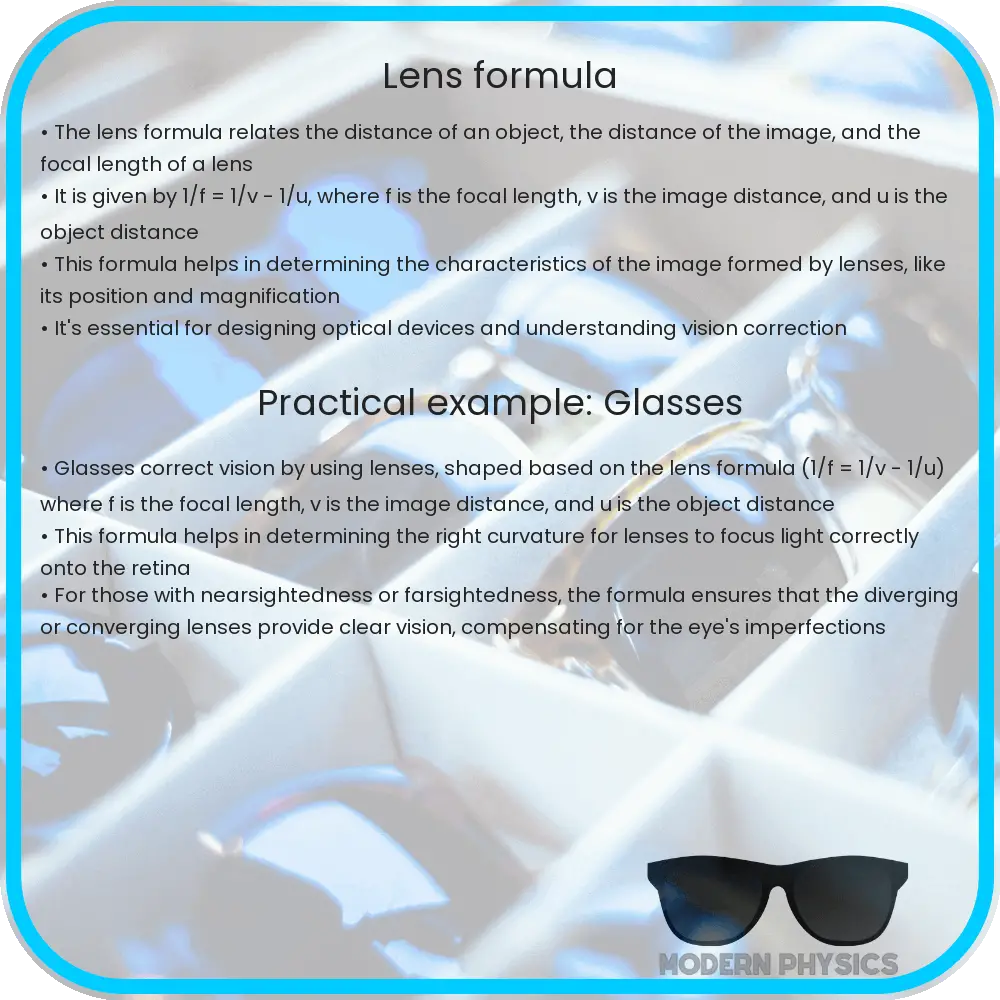Explore the lens formula in optics, its applications in technology and research, and the principles of image formation with converging and diverging lenses.

Lens Formula and Optics Principles
The lens formula is a fundamental concept in optics, providing a mathematical relationship between the distance of an object, the distance of its image from the lens, and the focal length of the lens. This formula is pivotal in various applications, including photography, eyewear, microscopes, and telescopes.
Understanding the Lens Formula
The lens formula is expressed as:
1/f = 1/v + 1/u
Where:
- f represents the focal length of the lens.
- v is the distance of the image from the lens.
- u is the distance of the object from the lens.
All distances are measured from the lens’s optical center. The focal length (f) is positive for converging lenses and negative for diverging lenses.
Converging and Diverging Lenses
Lenses are categorized into two types based on their shape and optical properties:
- Converging Lenses: These are thicker at the center than at the edges. They converge light rays at a point known as the focus. Examples include convex lenses.
- Diverging Lenses: These lenses are thinner at the center and thicker at the edges, causing light rays to diverge. Examples include concave lenses.
Image Formation by Lenses
The lens formula helps in determining the nature, position, and size of the image formed by lenses. The nature of the image (real or virtual) depends on the type of lens and the position of the object. For instance, a converging lens can produce both real and virtual images based on the object’s distance relative to the lens’s focal length.
Real images are formed when light rays actually converge at a point, while virtual images occur when light rays appear to diverge from a point. The size of the image can be calculated using the magnification formula:
M = -v/u
Where M is the magnification factor. A positive magnification indicates an erect image, while a negative value denotes an inverted image.
Understanding the lens formula and the principles of image formation is essential in optics. It enables the design and use of lenses in various devices, from simple magnifying glasses to complex optical instruments.
Is this conversation helpful so far?
Application of the Lens Formula in Optics
The lens formula is not just a theoretical concept; it has practical applications in many fields:
- Photography: In cameras, the lens formula is used to determine the focal length required to capture sharp images at various distances.
- Eyeglasses: Optometrists use this formula to prescribe lenses that correct vision by focusing light correctly onto the retina.
- Microscopes and Telescopes: These instruments use lens formulas to enhance the size, clarity, and detail of distant or microscopic objects.
Significance in Education and Research
The lens formula is a crucial topic in physics education, offering foundational knowledge in optics. It also underpins much research and development in optical technology, leading to innovations in fields ranging from medical imaging to astronomy.
Limitations of the Lens Formula
While the lens formula is widely applicable, it has limitations. It assumes that lenses are thin, which means the formula may not be accurate for thick lenses. Additionally, it does not account for aberrations – distortions in the image caused by the lens’s shape and material.
Conclusion
In conclusion, the lens formula, represented as 1/f = 1/v + 1/u, is a cornerstone of optical science. It enables the calculation of image positioning and size through converging and diverging lenses, essential in various technologies and scientific endeavors. The practical applications of this formula are vast, influencing fields like photography, vision correction, and scientific research. Despite its limitations, such as assumptions of thin lens and ignorance of aberrations, the lens formula remains a fundamental tool in understanding and manipulating light. Its role in educational settings is indispensable for students exploring the intricacies of light and vision. Overall, the lens formula is a testament to the elegance and utility of physics in unraveling the mysteries of light and enhancing our interaction with the world through optical devices.
